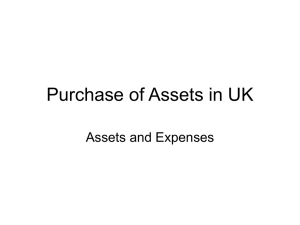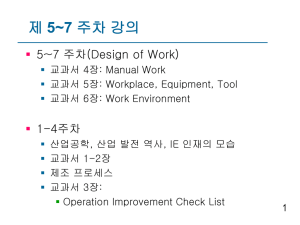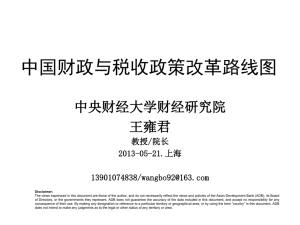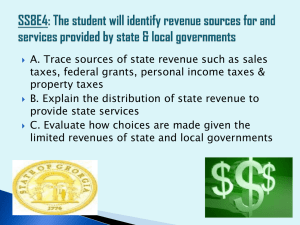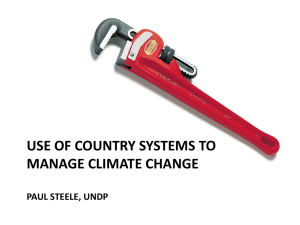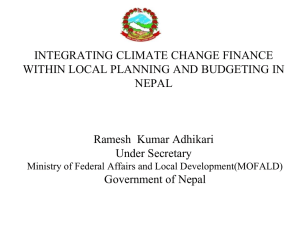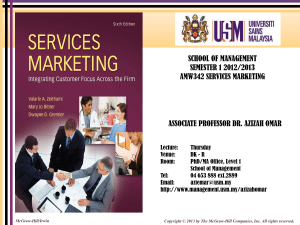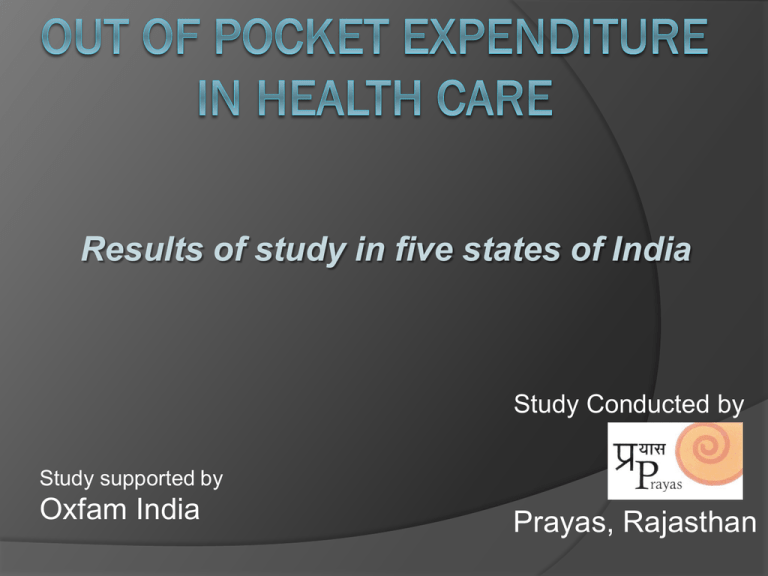
Results of study in five states of India
Study Conducted by
Study supported by
Oxfam India
Prayas, Rajasthan
Partner Organisations:
Rashtriya Grameen Vikas Nidhi, Assam
Child In Need Institute, Jharkhand
Rural Women’s Social Education Centre,
Tamilnadu
Chirag, Uttarakhand
Out of Pocket Expenditure (Oope) in
Health Care
OoPE are non-reimbursable fees which a patient or family is
responsible for paying directly to health practitioners or
suppliers, without intervention of a third party. It often occurs,
when publicly funded facilities are unable to provide the
required health services and supplies for free or through
insurance.
India was ranked as having the 42nd highest average OoPE,
with 74.4% of private expenditure being paid as out of pocket.
(WHS 2011)
OoPE accounts for an average increase in poverty by as
much as 3.6 and 2.9 percent for rural and urban India
respectively (Gupta 2009)
Spending on Health in Different
Economies of World
WHO, World Health Report 2008
Aim of the Study
Assess the nature of out of pocket payments of
households in health care and examine its relationship
with post 2004 new nation wide health initiatives viz.
NRHM, RSBY and many state led programmes.
Objectives of Study
Assess the change in out-of-pocket expenditure of
households for health care between 2004-10.
Examine the change in OoP expenditure in various
social and economic groups.
Analyse the pattern of OoP expenditure in relation to
various parameters of new post 2004 national health
initiatives viz. NRHM & RSBY
Research questions
Is there any reduction or increase in out-of-pocket
expenditure for households on health care post 2004?
Is there any reduction or increase in out-of-pocket
expenditure on health care in proportion to total
consumption expenditure of households?
Is there any difference in the pattern of OoP across
different (a) social and (b) economic categories?
Is there any effect of post 2004 new national health
programmes on the pattern of out-of-pocket expenditure
on health care?
6
S. No.
State
District
1.
Assam
Kamrup
2.
Sonitpur
3.
Cachar
4.
Jharkhand
5.
6.
Nagaur
8.
Tonk
9.
Baran
Sample size was fixed to
200 HH per district. This
was obtained by selecting
10 villages per district and
20 households per village.
Number of States :
5
Number of Districts :
14
Number of Villages :
140
Number of Households
surveyed :
2723
Vellore
11.
Coimbatore
12.
Virudhunagar
13.
14.
Tamilnadu
Districts and village in
states
were
selected
through PPS technique
(Probability Proportional to
Size Sampling Technique).
Bharatpur
7.
10.
Sahibganj
Purbi Singhbhum
Rajasthan
Sampling strategy
Uttarakhand
Tehri Garhwal
Nainital
7
Sample design
Stratified multi-stage design
The first stage units (FSU) were the 2001 census villages.
The ultimate stage units (USU) were households in villages. In
case of large villages requiring hamlet-group (hg) formation, one
intermediate stage was the selection of two hg’s from each FSU.
Formation of Second Stage Strata and allocation of households
Composition of SSS
No. of households to be
surveyed
Without hg
formation
With hg
formation
(for each hg)
SSS 1
Households with at least one member
hospitalized during last 365 days
8
4
SSS 2
From the remaining households,
households having at least one child of
age group 12-23 months
4
2
SSS 3
Other households
8
4
Survey tool
Survey tool was adapted from NSSO 60th
round.
There were two schedules –
for listing of households and
for in-depth interview of selected households
Field
data of the study was collected in the
months from March to May 2011
Profile of the sample group
Background
Variables
Total
Assam
Male
Female
50.2
49.8
51.3
48.7
0-14
15-29
30-44
45-59
60+
32.4
28.6
19.5
11.5
8.0
32.5
27.7
23.3
10.1
6.4
Hindu
Islam
Christian
Others
82.5
11.6
2.2
3.7
67.1
27.5
5.4
-
ST
SC
OBC
Others
15.2
19.7
40.0
25.1
24.9
9.9
26.4
38.7
Illiterate
Literate
24.2
75.8
12
88
Percentage
Jharkhand Rajasthan Tamil Nadu Uttarakhand
Sex
50.1
52
49.4
45.3
49.9
48
50.6
54.7
Age Group
39.5
32.7
25.3
31.9
25.5
31.2
27.6
28.6
18.7
16.9
23.1
17.0
9.8
11.7
14.3
11.2
6.5
7.4
9.7
11.3
Religion
51.2
93.9
94.5
100
23.1
6.1
2.1
4.1
3.4
21.6
Social Group
26.4
17.6
0.1
14.8
18.2
34.8
24.9
53.5
51.3
54.9
0.7
5.3
12.8
10.9
74.2
Literacy
34.5
27.5
12.3
15.4
65.5
72.5
87.7
84.6
Basic Household Amenities
and Infrastructure
S.N
o
Household
Characteristics
Total
1.
Pucca
Semi Pucca
Kachha
39.6
22.6
37.8
2
Tap
Tube
Well/Handpump
Pucca Well
Others
Bathroom Facility
Toilet Facility
Distribution
MPCE less than 500
MPCE 500-1000
MPCE 1000-2000
MPCE 2000 and
38.9
36.1
3.
4.
5.
Percentage
Assam Jharkhand Rajasthan Tamilnadu Uttarakhand
Household Type
9.5
9
43.1
25.3
23.7
15.4
65.2
67.3
41.6
Source of Drinking Water
1.9
0.3
21.5
41.1
74.0
56.4
49.8
42.4
7.8
95.4
1.3
3.2
99.0
0.0
79.0
3.0
11.7
21.9
21.6
13.2
0.2
0.3
13.3
35.1
4.1
8.9
0.8
17.7
38
47
4
13
67
66
31
56
5
12
27
66
of Household by MPCE (Monthly Per Capita Expenditure)
15.4
19.9
23.7
18.7
8.8
3
51.3
50.2
60.1
66.9
41.6
26.1
26
26.4
14.4
13.4
34.5
50.4
7.4
3.6
1.8
1
15.1
20.5
Basic Household Amenities
and Infrastructure
S.No
1.
Household Characteristics
Percentage
SC/ST OBC
Others
Distribution of type of household by social group
28.7
Pucca
38.3
56.1
Semi Pucca
19.3
29.9
15.5
Kachha
51.9
31.8
28.3
Distribution of main source of drinking water by social group
2.
3
4
Tap
31.9
40
46.4
Tube Well/Handpump
43.2
38
23.6
Pucca Well
Others
Distribution of household having bathroom facility by
social group
Distribution of household having toilet facility by social
group
12.9
12
27.2
13
9
35.2
8
21.9
57
17.8
27.1
56
Morbidity and Health Care
(Non-hospitalised case)
Proportion of Ailing persons (per 1000)
during last 15 days prior to the survey
Proportion of Ailing persons (per 1000) during last 15
days prior to the survey
(Comparison with NSSO 60th round)
88
90
70
80
64
70
60
50
40
30
20
10
0
Study findings
NSSO 60th round
(rural) (Avg. of
selected 5 states)
NSSO 60th round
(rural) (Whole India)
Proportion of Ailing Persons (per 1000)
during last 15 days by sex and age group
180
165
160
141
140
119
120
96
100
80
60
72
59
109
93
78
78
61
50 54
46
56
50
30
40
20
0
0-14
15-29
30-44
Male
45-59
Female
60+
Total
All
70
Proportion of Ailing Persons (per 1000) during
last 15 days by socio-economic characteristics
140
125
120
97
91
100
80
60
70
69
58
55
51
46
40
20
0
Less than
500
500-1000 1000-2000 More than
2000
MPCE Class
ST
SC
OBC
Social Group
Others
All
Proportion (Per 1000) of persons ailing and Proportion
of persons reported commencement of ailment one day
before the survey
140
130
120
107
100
80
89
70
62
60
40
20
0
44
PAP
PAC
41
31
29
12
9
14
Proportion (per 1000) of ailing persons
treated in outpatient
Proportion (per 1000) of ailing persons treated
in outpatient
(Comparison with NSSO 60th round)
890
885
880
860
870
860
850
840
820
830
820
810
800
790
780
Study findings
NSSO 60th round (rural)
(Avg. of selected 5 states)
NSSO 60th round (rural)
(Whole India)
Proportion (per 1000) of untreated spells of
ailment by reason for no treatment and
comparison with NSSO 60th round
419
450
400
320
350
280
300
240
250
200
150
162
155
120
100
50
156
30
54
54
10
0
No medical Lack of faith
facility
Long
waiting
Financial
problem
Ailment not
considered
serious
Study Findings
NSSO 60th round (rural) (Whole India)
Others
Per 1000 distribution of treated spells of ailments during
15 days by source of treatment for each MPCE class and
social group
658
700
600
500
400
300
200
100
0
581
581
576
502
498
419
419
424
551
540
449 460
541
536
464
459
342
Govt. Inst.
Pvt. Inst.
Per 1000 distribution of treated spells of
ailments during 15 days by source of treatment
(Comparison with NSSO 60th round)
780
740
800
700
600
500
541
459
Govt. Inst.
400
260
300
Pvt. Inst.
220
200
100
0
Study findings
NSSO 60th round
(rural) (Avg. of selected
5 states)
NSSO 60th round
(rural) (Whole India)
Average total expenditure (Rs.) , Average total medical expenditure
(Rs.) and expenditure on medicine (Rs.) for non-hospitalized
treatment per ailing person during last 15 days
382
Uttarakhand
1443
454
Tamil Nadu
336
Rajasthan
1848
Average Expenditure on Medicine
528
588
424
Jharkhand
1246
1732
804
Average Total Medical
Expenditure
Average Total Expenditure
1059
245
374
530
Assam
345
All
0
500
832
1000
1063
1500
2000
Average total expenditure (Rs.) for non
hospitalized treatment for each MPCE class
1600
1494
1400
1200
1097
1063
1000
800
625
600
407
400
200
0
Less than 500
500-1000
1000-2000
More than
2000
Total
Average total expenditure (Rs.) , Average total medical expenditure
(Rs.) and other expenditure (Rs.) for non-hospitalized treatment
per ailing person during last 15 days
(Comparison with NSSO 60th round)
1200
1063
1000
832
800
Average total expediture
600
365
400
322
Average total medical
expediture
Other Expenditure
284 257
231
200
43
27
NSSO 60th
round (Rural)
(Avg. of 5
selected 5
states)
NSSO 60th
round (Rural)
(Whole India)
0
Study findings
Proportion (per 1000) of household expenditure on
treatment during last 15 days by source of finance for
each MPCE class
761
707
642
500-1000
1000-2000
232
242
Borrowings
Others
148
HH Income/Saving
Borrowings
HH Income/Saving
121
Others
210
Others
Others
Less than 500
173
Borrowings
110
HH Income/Saving
128
Borrowings
525
HH Income/Saving
800
700
600
500
400
300
200
100
0
More than 2000
Morbidity and Health Care
(Hospitalised case)
Proportion (per 1000) of population
hospitalized during last 365 days
250
220
200
184
147
150
127131129
105
96
88
100
50
46
81 76 79
56 62 60
37 42
0
0-14
15-29
30-44
45-59
60+
All
Male
Female
Total
Proportion (per 1000) of population
hospitalized during last 365 days
(Comparison with NSSO 60th round)
79
80
70
60
50
40
18
30
23
20
10
0
Study findings
NSSO 60th round
(rural) (Avg. of
selected 5 states)
NSSO 60th round
(rural) (Whole India)
Proportion (per 1000) of population
hospitalized by MPCE class
138
140
120
98
100
71
80
58
60
40
20
0
Less than 500
500-1000
1000-2000
More than 2000
Per 1000 distribution of persons
hospitalized by type of ailment
159
395
148
21
142
27
82
27
Gastro-Intestinal
Cardio-Vascular
Eye Ailment
Febrile Illnesses
Disabilities
Gynecological
Accidents/Injury
Any Other
Proportion (per 1000) of hospitalized
cases by type of hospital
Proportion (per 1000) of hospitalized cases by type of
hospital (Comparison with NSSO 60th round)
580
600
521
479
510
490
500
420
400
300
Govt. Ins.
Priv. Ins.
200
100
0
Study findings
NSSO 60th round
(rural) (Avg. of
selected 5 states)
NSSO 60th round
(rural) (Whole India)
Proportion (per 1000) of hospitalized cases
by type of hospital in each MPCE class
655
700
600
500
550
521
479
508 492
450
400
345
300
200
100
0
Less than 500
500-1000
1000-2000
More than
2000
Govt. Inst.
Pvt. Inst.
Average Duration of Stay (in days) in
Hospital by Type of Hospital
Average Medical Expenditure (Rs.) per
hospitalization by sex and type of hospital
18920
20000
17715
18000
16000
14112
13701
14000
13459
10709
12000
10000
12617
8703
8183
8000
6000
4000
2000
Govt. Inst.
Pvt. Inst.
Total
Total
Females
Males
Total
Females
Males
Total
Females
Males
0
Average medical expenditure per
hospitalization by type of hospital for each
household MPCE class
25000
20785
20000
18154
19130
15000
12038
10000
9498
7557
8336
9229
5000
0
< 500
500-1000
1000-2000
> 2000
Govt. Inst.
Pvt. Inst
Average total expenditure (Rs.) , Average total medical expenditure
(Rs.) and expenditure on medicine (Rs.) for hospitalized case in last
365 days
11140
19168
20905
Uttarakhand
2960
16624
18331
Tamil Nadu
8498
Average Expenditure on
Medicine
Average Total Medical
Expenditure
Average Total Expenditure
16385
17620
Rajasthan
3050
Jharkhand
8070
9069
2441
4849
5562
Assam
6064
13459
14704
All
0
5000
10000
15000
20000
25000
Average total expenditure (Rs.) , Average total medical expenditure
(Rs.) and other expenditure (Rs.) for per hospitalized case during
last 365 days
(Comparison with NSSO 60th round)
16000
14000
14704
13459
12000
10000
6967
8000
Average Total Expenditure
6234
6000
6225
5695
Average Total Medical
Expenditure
Other expediture
4000
2000
1245
733
530
0
Study findings
NSSO 60th
round (rural)
(Avg. of
selected 5
states)
NSSO 60th
round (rural)
(Whole India)
Proportion (per 1000) of household expenditure
on treatment during last 15 days by source of
finance for each MPCE class
459
361
281
306
333
368
325
308
Others
326
337
Borrowings
382
Less than 500
500-1000
1000-2000
HH Income/Saving
Others
Borrowings
HH Income/Saving
Others
Borrowings
HH Income/Saving
Others
Borrowings
215
HH Income/Saving
500
450
400
350
300
250
200
150
100
50
0
More than 2000
Maternal and Child Health
Proportion of children Immunized (per 1000)
Expenditure incurred on Immunization (in Rs.)
Per 1000 distribution of childbirth by place
of delivery for each broad age group
900
818
800
711
659
700
600
595
600
500 500 500 500
500
Government
Institution
Private
Institution
Home
381 400
400
300
200
182
184
105
216
125
100
24
0
0
0
35-39
40-44
0
0
15-19
20-24
25-29
30-34
45-49
Average expenditure (in Rs.) per childbirth
by place of delivery
14000
12500
12000
10000
8000
11100
8673
7050
7428
6000
4000
2000
0
3738
2500
2440 2145
2166
2042
1801
1116 1216
710
695
689 832
556
0
0
3489
Government
Institution
Private
Institution
Home
2497
1340
Total
Proportion (per 1000) of women who availed
antenatal care services (PWANC) by source of
institution for availing the facilities
962 960
1000
900
888
817
939
857
800
932
861
846
726
830
677
700
600
Total
Government Institution
Private Institution
500
400
323
300
200
100
0
143
112
40
61
68
Average expenditure (Rs.) on antenatal care
services (ANC) by woman by source of service
3500
3175
3000
2500
2000
1811
1744
1500
1118
1000
500
516
270
575
400
6130
0
591
304
20
All
Government Institution
Private Institution
825
707
153 325
165
Proportion (per 1000) of women who availed
post-natal care services (PWPNC) by source of
institution for availing the facilities
1000
1000
900
897
882
826
813
784
800
700
978
700
634
584
600
571
531
500
Total
Government Institution
Private Institution
429
400
300
200
100
0
216
118
103
0
22
Average expenditure (Rs.) on post-natal care
services (PNC) by woman by source of service
1800
1625
1600
1400
1200
1000
964
1000
763
800
600
400
200
0
900
850
475
500
380
225
All
522
353
122
122
0
122
9470
Government
Institution
Private
Institution
Change in oop spending and treatment seeking
from public institutions between 2004 - 2011
Average expenditure (Rs.) for non-hospitalised per ailing person
All
(avg. of 5
states)
365
Assam
Jharkhand
Rajasthan
Tamil Nadu
Uttrakhand
261
370
436
208
551
628
449
636
750
358
948
1063
530
1059
588
1848
1732
69.26 %
18.04 %
66.50%
NSSO 60th
round(2004)
NSSO 60th round after
inflation adjusted
Prayas study(2011)
% change
- 21.60 % 416.20 % 82.70 %
Non –hospitalized ailing persons (per 1000) seeking care from
public health institutions
NSSO 60th
round(2004)
Prayas
study(2011)
All
(avg. of 5
states)
262
Assam
Jharkhand
Rajasthan
Tamil Nadu
Uttrakhand
270
130
440
290
180
541
857
64
490
310
656
217.40 %
-50.76 %
11.36 %
6.89 %
264.44 %
% change 106.48 %
Change in oop spending and treatment seeking
by from public facilities between 2004 & 2011
Average expenditure (Rs.) for hospitalised per ailing
All
Assam person
Jharkhand
Rajasthan
Tamil Nadu
Uttrakhand
(avg. of five
states)
NSSO 60th round(2004)
6967
4697
5338
8294
5775
10731
NSSO 60th round after
inflation adjusted
Prayas study(2011)
11983
8079
9181
14266
9933
18457
14704
5562
9069
17620
18331
20905
% change
22.70 %
- 31.15 %
- 1.22 %
23.51 %
84.54 % 13.26 %
Hospitalized persons (per 1000) seeking care from public
health institutions
All
(avg. of five
states)
Assam
Jharkhand
Rajasthan
Tamil Nadu
Uttrakhand
NSSO 60th round (2004)
514
742
466
521
408
431
Prayas study (2011)
479
847
195
553
271
408
% change
- 6.80 %
14.15 %
-58.15 %
6.14 %
-33.57 % -5.33 %
Chief findings of the study
There is three fold increase in oope in
out patients and two fold increase in
hospitalised patients.
Tamilnadu which supposedly has better
public health system and free medicine
scheme since 1995 has recorded
highest increase in oope amongst out
patients.
Maximum oope in Tamilnadu is on
medical
expenditure
other
than
medicines.
Chief findings of the study
Significant rise in out patients seeking care
from public health institutions but marginal
decline in hospitalised patients.
Jharkhand showed highest decline in use of
public health facilities both by hospitalised
and non-hospitalised patients.
Lessons learnt
Oope is an important indicator to determine
over all health services utilisation.
Oope assessment assists in identification of
the components of health services which
require improvement . For instance in
Tamilnadu, there is a need to examine the
quality and actual availability of public
health services to arrest decline in utilisation
of public health services.
Recommendations
Urgent need to reduce oope considerably.
Expenditure on medicine ought to be completely
eliminated.
other medical expenditure also should be close
to zero in all public and trust (charitable)
hospitals.
Oope relating to total medical expenditure should
be considerably reduced by increasing physical
access.
Quality of care provided by the health institutions
is required to be strictly as per IPHS guidelines
both in public and private.
Recommendations
Private practice by the providers of
public health system should be
completely banned.
User fee completely aolished.
Standard
treatment guidelines are
required to be followed by all health
service providers and directorates of
rational
therapeutics
should
be
established at national and state
headquarters.
Recommendations
Accessibility and quality of health
services ought to be evaluated and
monitored through community groups
regularly
for
feedback
and
improvements.
Thank
you



